Best monitors for video editing of 2024: top picks for all budgets
We're tracking our picks for the best monitors for video editing in 2024
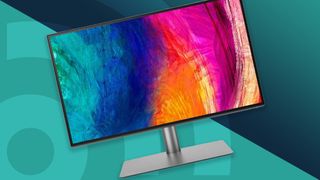
1. Quick List
2. FAQs
3. How to choose
4. How we test
5. Top picks
▶ Best overall
▶ Best budget
▶ Best for Mac
▶ Best 8K
▶ Best 6K
▶ Best for content creators
The best monitor for video editing will enhance any project, whether it's a cinematic production or content for social media, offering unmatched color accuracy, extensive color gamut, and sharp resolutions for a more efficient and visually comfortable post-production process.
Selecting the ideal monitor involves more than just opting for a standard desktop display to pair with the best video editing PCs or even the best video editing laptops. It requires a monitor that complements the capabilities of high-end video editing setups and software, including factory-calibrated settings, color-accurate screens, wide color space coverage. Our experts have rigorously tested a range of monitors, evaluating their contrast, brightness, pixel density, and durability to find the perfect fit, from home setups to professional studios.
Our recommendations cover a spectrum of needs and budgets, including cost-effective options and premium 4K monitors, ensuring your video content is flawless from the first preview to the final cut.
Quick List

The BenQ PD2725U excels as a 4K monitor for professionals, offering 100% sRGB accuracy and dual view function for multitasking, despite its weaker built-in speakers. It features versatile connectivity options, including a KVM switch, but commands a premium price.

The Asus ProArt PA279CRV offers the ProArt line's renowned accuracy and color coverage at an affordable price, with strong connectivity options including USB-C and display daisy-chaining. While limited in HDR and refresh rate, its quality, adjustability, and design make it an exceptional value for productivity and content creation.

The Apple Studio Display, a more affordable counterpart to the Pro Display XDR, targets creative professionals with its 27-inch 5K IPS display, offering vibrant colors and sharp images despite lacking some MacBook Pro features and HDR support, striking a balance between affordability and performance.
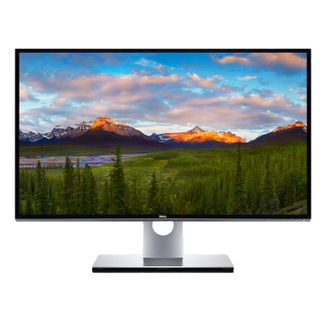
Five years post-launch, this 32-inch 8K monitor remains remarkable for future-proofing workflows, despite its high price and limited 8K content production. Boasting robust design, excellent ergonomics, superior brightness, and color accuracy, it's an ideal choice for cutting-edge video editing, anticipating a surge in 8K content creation.
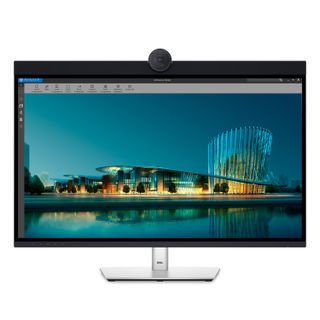
Dell's U3224KB UltraSharp 6K Monitor merges a display, Thunderbolt hub, 4K webcam, and soundbar, offering a 32-inch 6K display with high color accuracy and HDR. It's a cost-effective, feature-rich alternative to Apple's offerings, perfect for productivity-focused professionals.
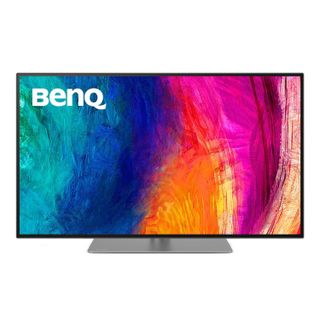
The BenQ PD3220U is a top-tier 4K monitor combining elegance with functionality, featuring a well-built metal base, built-in KVM switch, and impressive specs like high resolution, HDR capability, and 100% sRGB color gamut for vibrant, accurate visuals in video editing.
Best video editing monitors: FAQs
What are the different monitor panel types?
In terms of LCD display panels, nowadays there are three main types starting with TN (twisted nematic) which is the oldest and cheapest. Then we have Vertical Alignment (VA), In-Plane Switching (IPS), and OLED. Video editing is more efficient with IPS panels because of their ability to produce a wide gamut of colors. Motion-blurring is a problem with VA panels when displaying fast-paced footage, and OLED have better blacks but still have a high cost and other problems.
When using a monitor for video editing, brightness, contrast, and color gamut are the most important considerations. A monitor's color gamut refers to the possible range of colors it can display. Although all LCD monitors nowadays have good contrast ratios, brightness levels, and color gamuts, the IPS LCD panels have better viewing angles and support more colors than their TN predecessors.
Your monitor also must be calibrated properly if you want color accuracy.
How to choose the best monitors for video editing
Choosing the right video editing monitor involves considering color accuracy, with at least 95% DCI-P3 gamut coverage recommended, and size, where 27 to 32 inches offers a comfortable viewing range, with ultrawide options above 34" providing optimal space.
The aspect ratio is crucial, with 16:9 being standard, though ultrawide ratios like 21:9 offer additional workspace.
Resolution is key for detail, aiming for a display that exceeds your output resolution, making 4K panels a solid choice for 4K video editing. HDR support enhances image depth and realism, important for HDR content.
Connectivity is also vital, ensuring compatibility with your computer's output types, with USB-C offering a streamlined, single-cable solution for modern laptops and peripherals, enhancing the overall editing workflow.
How we test the best monitors for video editing
Our experts have rigorously evaluated a vast array of displays, including the best monitors for photo editing and the best business monitors. So, we know what to look out when looking for a screen for video editing. We set aside Full HD 1080P for the superior 4K UHD here, essential for current and future video editing due to the ubiquity of 4K content.
Given the prevalence of 4K recording in devices from the iPhone 7+ to the Samsung Galaxy S8, investing in anything less is short-sighted.
We recommend 27-inch monitors as the optimal entry point for serious editing, with 31", 32", and 34" as excellent choices for larger screens, avoiding anything over 40" for practicality.
Our selection exclusively features IPS panels for their color accuracy, crucial for video editing. Notably, all our top picks, except the Dell 8K, support HDR, with some offering HDR600, indicating HDR compatibility with peak brightness up to 600 nits.
This curated list spans various price points, ensuring a choice for every video editing need, prioritizing resolution, display size, and HDR compatibility.
The best monitor for video editing: our top picks
The best monitor for video editing in 2024
Why you can trust TechRadar
Below you'll find full write-ups for each of our picks for the best monitor for video editing. We've tested each one extensively, so you can be sure that our recommendations can be trusted.
Best monitor for video editing overall
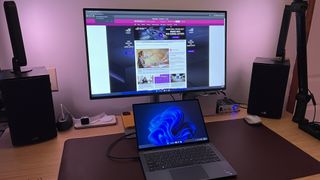
Specifications
Reasons to buy
Reasons to avoid
The BenQ PD2725U is a great choice for professional video editors, and anyone else looking for one of the best 4K monitors for video editing. The screen boasts 100% sRGB color accuracy, a vibrant 4K UHD resolution, and a sleek, slim bezel design that will complement any setup.
Professionals working with graphic design or video editing software will get a lot of use from the monitor’s dual view function. The feature lets you better organize screen space, letting you ‘split’ the screen to show different content on each side. Useful for previewing projects in a range of color spaces and screen sizes. One of the biggest drawbacks for us during testing was the quality of the built-in speakers. They're a lot weaker than rival monitors, and we found it best to hook up a headset or external speakers.
Connectivity-wise, BenQ PD2725U is fairly well-kitted, with HDMI, DisplayPort, and USB-C. You’ll also find a built-in KVM switch for switching between computers without switching keyboard and mouse. The video editing monitor’s stand offers a good amount of flexibility, letting you adjust height, tilt, and pivot to find the best viewing angles. All those great features, though, means the display comes in at a premium price point.
Read our full BenQ PD2725U review
The best budget video editing monitor
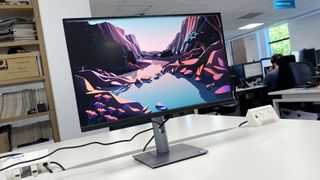
Specifications
Reasons to buy
Reasons to avoid
Asus's ProArt panels are usually pretty pricey. But the new Asus ProArt PA279CRV gives you the usual ProArt experience including accurate factory calibration and excellent color coverage in a surprisingly affordable package.
Connectivity is also a strong point thanks to not only USB-C with 96W of power delivery and a dual-port USB-A hub, but also a downstream DisplayPort output allowing for display daisy chaining. The 27-inch 4K form factor is fundamentally great, too, and allows for excellent pixel density and lovely crisp fonts in both Windows and MacOS.
Sure, the HDR support is limited to DisplayHDR 400 with no local dimming. So this isn't a true HDR panel and the inherent contrast of the IPS panel isn't great. It's also limited to 60Hz rather than 120Hz or 144Hz. But then that's the norm for this class of productivity panel.
Anyway, factor in the fully adjustable stand and slick styling and this is one heck of a monitor for the money. You'd have to spend dramatically more to get a tangibly better monitor. A good monitor for video editing if you're new to the art or you're working to a budget, the Asus ProArt PA279CRV is a fantastic value for all manner of productivity and content creation workflows.
Read our full Asus ProArt PA279CRV review
The best video editing monitor for Mac

Specifications
Reasons to buy
Reasons to avoid
The Apple Studio Display was introduced as a accessible alternative to the Apple Pro Display XDR, and was designed with video, graphic design, and creative professionals in mind.
Offering a compelling blend of affordability and quality for Apple enthusiasts, its 27-inch 5K IPS display impresses with vibrant colors and sharp imagery, although it doesn’t match the MacBook Pro's brightness or feature the advanced Liquid Retina XDR and mini LED technology. The lack of HDR support is a notable omission for a monitor at this price point, unfortunately.
Despite its shortcomings, the Apple Studio Display is priced competitively within the professional creative market, offering a balance between cost and performance for video content creators, distinguishing itself from options geared towards gaming or general office tasks.
Read our full Apple Studio Display review
The best 8K monitor for video editing

Specifications
Reasons to buy
Reasons to avoid
Even five years after its announcement, the model is still outstanding and astounding today. However, it continues to have a high price and little competition, perhaps because there isn’t a lot of 8K content available and everyone is still producing mostly 4K video content. But if you're future-proofing workflows, this PC monitor for video editing is certainly an eye-catching option.
With the new breed of high-end smartphones already capable of 8K video recording, the flood of 8K content is likely to make other monitor manufacturers jump aboard the 8K monitor bandwagon.
The 32-inch size of this beast doesn't let it go unnoticed, even when it is turned off. From the outside, you get a pretty sturdy design and impressive construction as per usual with Dell, all wrapped up in stylish brushed aluminum. In addition to the great ergonomics -again another hallmark of Dell- it has support for height adjustment, tilt, pivot and portrait mode features.
Most IPS screens in this line up have a brightness of around 350 cd/m2, however, this one has a brightness of 400 cd/m2. Moreover, its contrast ratio also tops the list at 1300:1. The panel's color gamut is one of the best we have seen with 100% of sRGB, 100% of Adobe RGB, and 98% of DCI-P3.
Regarding connectivity, it includes two DisplayPort connections, a USB hub with one upstream and two downstream ports and an audio line out jack. If you're looking for an 8K monitor for video editing, look no further than this tech marvel.
Read our full Dell UltraSharp UP3218K review
The best 6K video editing monitor
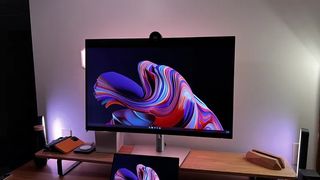
Specifications
Reasons to buy
Reasons to avoid
Dell's U3224KB UltraSharp 6K Monitor isn't just a display; it's a multifunctional device combining a monitor, Thunderbolt hub, 4K webcam, and soundbar in one sleek package.
It's designed with productivity in mind, boasting a 32-inch 6K IPS Black display with 99% Display P-3 color accuracy and VESA DisplayHDR 600. The integrated 4K webcam with AI and manual tilt adjustments enhances video conferencing, while the built-in Thunderbolt 4 hub simplifies connectivity, allowing for a one-cable connection to devices.
An auto KVM switch enables easy multitasking between computers. Impressively, this monitor rivals Apple's Studio and Pro Display XDR in quality and features but at a more affordable price and with a wider variety of ports, making it an ideal choice for professionals seeking a high-performance, versatile workstation monitor.
Read our full Dell U3224KB UltraSharp review
Best video editing monitor for content creators

Specifications
Reasons to buy
Reasons to avoid
Blending elegance and professionalism, the BenQ PD3220U proves itself a very capable and attractive 4K computer monitor for video editing. During our testing, we liked the high-quality build and its attractive design. The solid metal base, in particular, is well-constructed, allowing smooth adjustments to the viewing angle. If you’re working on multiple computers, you’ll appreciate the built-in KVM switch to move between machines without changing keyboard and mouse.
The specs, too, are impressive. The crisp 4K resolution, high pixel density, wide color gamut provided a sharp and vibrant display. HDR capability, allowing for greater contrast between light and dark in images, was a real stand-out feature. We found it added depth and dimensionality for an immersive viewing experience.
As with many screens at this price-point, the speakers leave something to be desired (however nice they are to have). But the real stand-out here is the 100% sRGB color gamut and 10-bit color depth, producing vibrant, accurate colors, ideal for photo and video editing projects.
Read our full BenQ PD3220U review
Today's best video editing monitor deals
Are you a pro? Subscribe to our newsletter
Sign up to the TechRadar Pro newsletter to get all the top news, opinion, features and guidance your business needs to succeed!

Steve is TechRadar Pro’s B2B Editor for Creative & Hardware. He explores the apps and devices for individuals and organizations that thrive on design and innovation. A former journalist at Web User magazine, he's covered software and hardware news, reviews, features, and guides. He's previously worked on content for Microsoft, Sony, and countless SaaS & product design firms. Once upon a time, he wrote commercials and movie trailers. Relentless champion of the Oxford comma.
- Mark Pickavance
- Fernando Cassia
- John LoefflerComponents Editor
- Collin Probst
